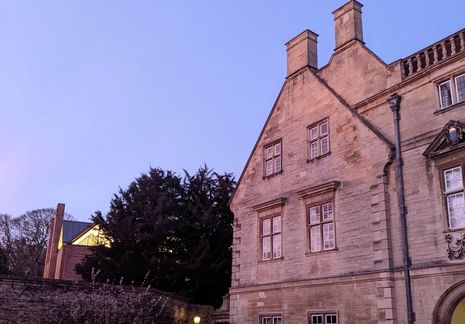Living in a looking glass, darkly
Clementine Lussiana takes a deeper look at the world of the ‘aesthetic’, asking whether, rather than defining ourselves by who or what we look like, we should let what we look like be determined by who we are

Substance is out of fashion.
It has been succeeded by appearance. We live in a world where images are seized, doctored and spewed over different platforms. With this hyper-fixation on how we look, how we are has fallen by the wayside.
This is embodied in a phenomenon: The aesthetic; the chronicling of looks into varied online subcultures. ‘Types’ of people are categorised, given highly specific qualities, and promptly romanticised by a digital audience. The categories come in a multitude of niche forms, some of which have gained more attention than others. Dark academia is a popular example: a visual depiction of mystery and elitism, of higher education, of the classics. The dark academic is brooding, sullen. They wear loafers and have ink-stained fingers. They work largely, but not exclusively, in dimly lit libraries. They enjoy muted colours, blazers, and anything even vaguely related to Donna Tartt.
“In person, your ‘look’ is influenced by how you act, what you say. But online, how you look is everything”
There is a plethora of these aesthetics. Soft girl, cottage-core, twee… the list goes on. A wide range of looks to subscribe to, to emulate. They portray a lifestyle too: see the Tik-Tok ‘it girl’, who has claw clipped, green tea-d and chunky gold jewellery-d her way into our lives. Her daily routine is coveted and copied. They are a modernised, multiplied version of the clichéd American trope of high-school jocks, nerds and beauty queens. And they have blown up, the evidence being the surge in micro-trends. Because as aesthetics rise and fall in popularity, so do the clothes that go with them.
The replication of an image allows one to temporarily live an illusion. There’s nothing inherently wrong with this - it’s liberating, after all, to be transported to another life, or to present a handpicked version of yourself to society. Besides, everything has been done for us. We are taught how to fulfil a look by Pinterest mood boards and Tik-Tok ‘step by steps’. There’s no denying it makes things easier.
Yet there is something about it all that does not ring true. Because surely the external should be a product of the internal? Surely our ‘look’ should be a representation of who we are? In a culture of replication, we are becoming increasingly hollow. Yes, a crumpled white shirt and carefully applied under-eye-shadows might make you look like a dark academic, might make people think you’ve spent the night at bacchic rituals or doing unspeakable things in the library. But you’re not, and you haven’t. Is the following of aesthetics something that is at its heart, completely artificial?
A fixation on our looks, countenance, and style has left our substance in cold neglect. The phenomenon of appearance has stifled attention towards the authentic self. The thing is, thoughts, passions, fears - they can’t be chronicled. They can’t be packaged neatly into containers, as clothes or makeup looks can. They’re too messy, too volatile. They shift and grow. They are frightening and overwhelming and visceral. There is nothing ‘aesthetic’ about that.
“A fixation on our looks, countenance, and style has left our substance in cold neglect”
Like almost every other modern phenomenon, this is down to social media. After all, online we are depicted visually, far more so than we are in person; in person, your ‘look’ is influenced by how you act, what you say. But online, how you look is everything. How you look is who you are. Because what else can it be based on? The quality of your captions?
The obsession of categorising the external arises from the modern fixation on image. It makes sense - if how we look is who we are, then it doesn’t matter so much what we feel like inside. We can simply assign ourselves to a subgroup by picking a category - by choosing an aesthetic. It is easier to copy than to be. To be, in a world where one’s own appearance is constantly undermined by the photo-shopped, distorted beauty that we numbly double-click, is terrifying.
I know. The importance of appearance is not exclusive to our generation. Perhaps it has always been more valued than substance, and perhaps looks, countenance, and style have always been more impactful than thoughts and passion. The difference is, now we have tangible ways of measuring the quality of someone’s look. We have whole platforms dedicated to it. Our world is image-riddled, over-saturated with posts, stories, Zoom calls. We don’t just accommodate this phenomenon, we feed it. And, worse, any movement that diverts from the replication of an image, any blind attempt to be ourselves is futile. An impossibility when every move categorises you further- is a subconscious step towards a pre-curated aesthetic.
But.
We’re only categorised if we subscribe to an image-fixated culture. There is hope, so long as we shatter, not glass ceilings, but the four borders of photos that dominate our feed. If we acknowledge that the phenomenon of the ‘aesthetic’ is a reflection of a society with skewed priorities. And when it becomes more popular to have read Donna Tartt than to look like the kind of person who reads Donna Tartt - that’s when we win.
 News / CUP announces funding scheme for under-represented academics19 December 2025
News / CUP announces funding scheme for under-represented academics19 December 2025 News / SU reluctantly registers controversial women’s soc18 December 2025
News / SU reluctantly registers controversial women’s soc18 December 2025 News / Cambridge welcomes UK rejoining the Erasmus scheme20 December 2025
News / Cambridge welcomes UK rejoining the Erasmus scheme20 December 2025 Features / Should I stay or should I go? Cambridge students and alumni reflect on how their memories stay with them15 December 2025
Features / Should I stay or should I go? Cambridge students and alumni reflect on how their memories stay with them15 December 2025 Film & TV / Timothée Chalamet and the era-fication of film marketing21 December 2025
Film & TV / Timothée Chalamet and the era-fication of film marketing21 December 2025










